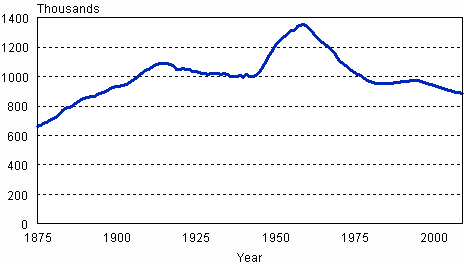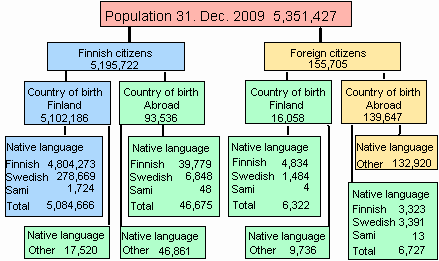Published: 19 March 2010
Number of persons aged under 15 in Finland’s population lowest in over 100 years
According to Statistics Finland’s statistics on the population structure there were 888,323 persons aged under 15 in Finland’s population at the end of 2009. The number is the lowest since 1895. The size of the population under the age of 15 has been decreasing continuously since 1994. At the end of 1977, there were still one million persons aged under 15 in the Finnish population. The size of the population under the age of 15 was at its largest in 1959 when it was 1.35 million.
Number of persons aged under 15 in Finland’s population in 1875–2009

On 31 December 2009, the total population of Finland was 5,351,427 in which 2,625,067 were men and 2,726,360 women. In the course of 2009, Finland’s population grew by 25,113 persons. For the third successive year migration gain from abroad contributed more to the increase of population than natural growth.
During 2009, the number of persons aged 65 and over in the population increased by good 18,000 and totalled 910,441 at the end of 2009. The largest age cohort in Finland’s population was persons born in 1948. At the end of 2009, they numbered 82,738. Persons over 100 years of age numbered 566, of whom 82 were men and 484 women.
Demographic dependency ratio highest in Etelä-Savo and lowest in Uusimaa
The demographic dependency ratio, that is the number of under 15 and over 65-year-olds per 100 working age persons was 50.6 at the end of 2009. Examined by area, the demographic dependency ratio was highest in the regions of Etelä-Savo, 58.3, and South Ostrobothnia, 57.4. The demographic dependency ratio was lowest in the region of Uusimaa (43.4) and Pirkanmaa (50.2). Examined by municipality, the demographic dependency ratio was highest in Luhanka, 89.5, Kivijärvi, 82.2, and Multia, 80.9, and lowest in Helsinki, 39.1, Tampere, 41.8, and Järvenpää, 41.8.
Population increased in 12 regions and 141 municipalities
During 2009, the population increased in 12 and decreased in 8 regions. In absolute numbers the population grew most in the regions of Uusimaa, by 15,556 persons, and Pirkanmaa, by 3,731 persons. In relative terms the population grew most in the regions of Uusimaa, by 1.1 per cent, and Åland, by 1.0 per cent. In absolute numbers the population decreased most in the regions of Etelä-Savo, by 1,064 persons, and Kainuu, by 526 persons. In relative terms the population decreased most in the regions of Etelä-Savo, by 0.7 per cent, and Kainuu, by 0.6 per cent.
Four municipal mergers took effect as of the beginning of 2010, in consequence of which the number of municipalities in Finland decreased by six. There are now 342 municipalities in Finland. During 2009, the population grew in 141 and diminished in 199 municipalities. Helsinki had the biggest absolute increase in population (6,718 persons), followed by Espoo (2,765 persons) and Vantaa (2,239 persons). Kouvola had the biggest absolute decrease in population (262 persons), followed by Varkaus (247 persons) and Kauhava (228 persons).
Number of foreign-language speakers exceeded 200,000
Of the population of Finland 4,852,209 persons (90.7%) spoke Finnish, 290,392 persons (5.4%) Swedish and 1,789 persons (0.03%) Sami as their native language. Persons with a native language other than Finnish, Swedish or Sami numbered 207,037, or 3.9 per cent of the population. The number of foreign-language speakers has doubled in nine years. The largest foreign-language groups spoke Russian (51,683 persons), Estonian (25,096 persons), English (12,063 persons), Somali (11,681 persons) and Arabic (9,682 persons).
At the end of 2009, the number of Finnish citizens permanently resident in Finland was 5,195,722, of whom 93,536 had been born abroad. Foreign citizens resident in Finland numbered 155,705, or 2.9 per cent of the population. The number of foreign citizens grew by 12,449 persons during 2009. According to the 2007 statistics of Eurostat, Finland had the seventh lowest proportion of foreign citizens in total population among all the present EU27 countries. The largest groups of foreign citizens were from Russia (28,210 persons), Estonia (25,510 persons), Sweden (8,506 persons) and Somalia (5,570 persons). The number of persons born abroad but resident in Finland was 233,183.
Country of birth, citizenship and mother tongue of the population 31.12.2009

Source: Population Structure 2009, Statistics Finland
Inquiries: Markus Rapo (09) 1734 3238, vaesto.tilasto@stat.fi
Director in charge: Jari Tarkoma
Publication in pdf-format (340.4 kB)
- Tables
-
Tables in databases
Pick the data you need into tables, view the data as graphs, or download the data for your use.
Appendix tables
- Regional adjustments 1.1.2010 (19.3.2010)
- Population by area 31.12.2009 and increase of population (19.3.2010)
- Population by age 1875 - 2009 (19.3.2010)
- Figures
-
- Population in Finland 1750 - 2009 (19.3.2010)
- Population by age 31.12.2009 (19.3.2010)
- Population by age, marital status and sex 31.12.2009 (19.3.2010)
- The largest groups by native language 1999 and 2009 (19.3.2010)
- Foreign nationals by sex 1980 - 2009 (19.3.2010)
- Quality descriptions
-
- Quality description: Population structure 2009 (19.3.2010)
Updated 19.3.2010
Official Statistics of Finland (OSF):
Population structure [e-publication].
ISSN=1797-5395. 2009. Helsinki: Statistics Finland [referred: 19.4.2024].
Access method: http://www.stat.fi/til/vaerak/2009/vaerak_2009_2010-03-19_tie_001_en.html

